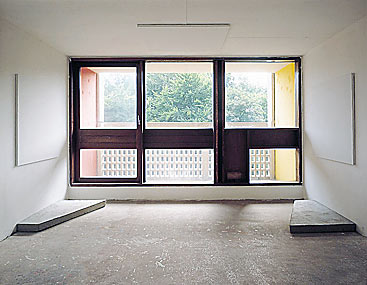
Born in 1941 in Trois-Moutiers (FR)
Lives and works in Vaucresson (FR)

1979
Material and dimensions variable
Year of Purchase: 1992
Definition method no.103
1) The elements on the floor, A, B, C, D, are made of the same material as the floor.
2) Element E is a canvas on a stretcher painted the same colour as the wall on which it is affixed.
3) The elements on the ceiling F, G, H, I, may be made of several materials. This will depend on the place and the easiest solution to be applied will be adopted. These elements will be painted the same colour as the ceiling.
4) Element I is a corner element made of a single piece and will in all probability be a sheet of folded metal, the part on the ceiling being painted the same colour as the wall.
The other elements in the work will be chosen at the moment of execution.
The argument of the proposition Sol/Mur/Plafond/Mur (Floor/Wall/Ceiling/Wall) is the mobilization of all the surface types in the place of its execution. Actually, it stipulates the arrangement, on the floor, of four elements made of the same material as their support; it programmes the hanging, on the wall, of a canvas on a stretcher painted the same colour as this wall; it recommends the placing, on the ceiling, of four elements, the material of which, on the one hand, is left up the choice of the person who assumes responsibility for the piece and, on the other, may vary from one element to the next; lastly, it provides for the installation, at the corner of the ceiling and the wall, of one element, a sheet of folded metal for example, where the part against the ceiling will be painted the same colour as it and the part against the wall will be painted the same colour as this latter.
The first effect of such a proposition is the equalization of the exhibition space. For not only is no type of surface (wall, ceiling, floor) overlooked, but in addition all the elements used have with their respective surfaces a similar mimetic relation, in this instance. A similar de-hierarchization of the place of presentation is further heightened by the parity of the number of elements on the floor and wall. Lastly, with the introduction of a hybrid element from a topics viewpoint, a sheet of folded metal, straddling the wall and the ceiling, this effect of the equalization of the exhibition space is drawn: since wall and ceiling are equal, there is no need to change the object in order to shift from one to the next.
The second effect is the equalization of the paint and sculpture obtained. First and foremost, this piece is a mixture because it associates typical elements of the painterly and sculptural fields: a painted canvas on a stretcher on the wall and sheets of material (cement, wood, stone, for example) or bits of carpet or linoleum on the floor. Then there are certain mobilized elements which, depending on the choices of execution made, will work as mixed; the same thus goes for elements on the ceiling, clearly three-dimensional and painted, like the nearby canvas, of the same colour as the support. Lastly, the elements representative of the sculptural genre and the element emblematic of the pictorial genre establish with their respective supports a similar relation: the sheets or bits of cladding resemble the floor on which they are laid just like the painted canvas resembles the wall on which it is hung. Now, if painting and sculpture can thus be subject to one and the same treatment, this is because of the existence of certain similarities between them. Both can have as direct support this kind of surface of the place of their presentation, both can imitate this support, and both can even be homologous objects. If the elements on the floor are sheets of cement, and if the canvas on the wall has the same dimensions, in this case, the exchange to which the spectator will be invited to proceed will quite simply be that of two parallelepipeds. Otherwise put, with the comparison of this kind of canvas and these kinds of sheets, the difference between painting and sculpture becomes relativized, with the canvas on the stretcher appearing for what it is, a three-dimensional object and not as the mere support of pictorial traces.
So with Sol/Mur/Plafond/Mur (Floor/Wall/Ceiling/Wall, at the same time the exhibition space and the canvas on the stretcher strike the eye in their volumetric definition.
Michel Gauthier